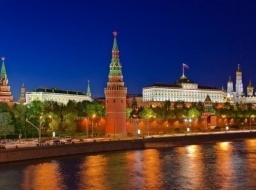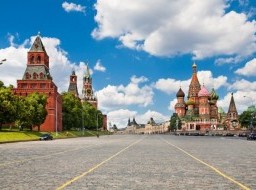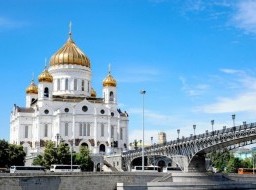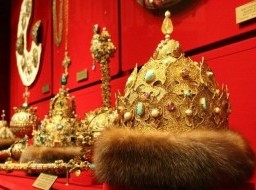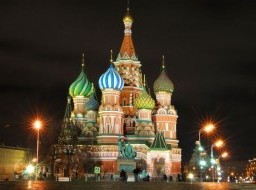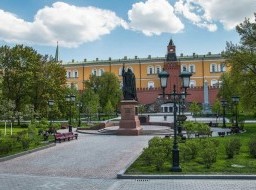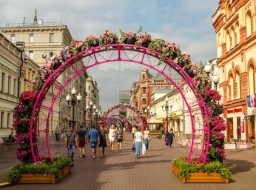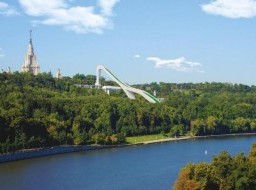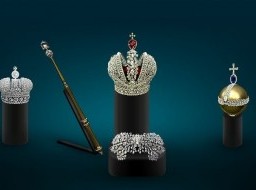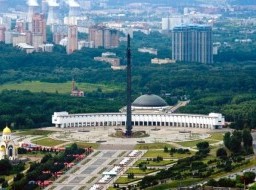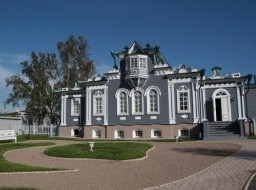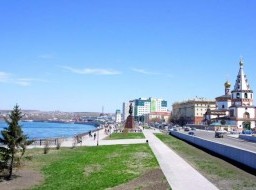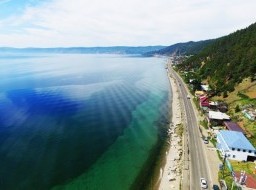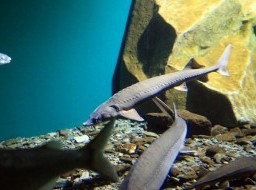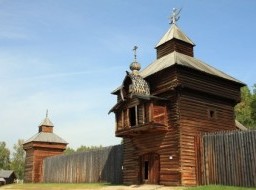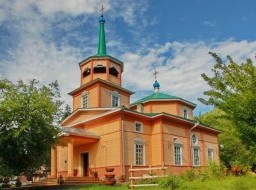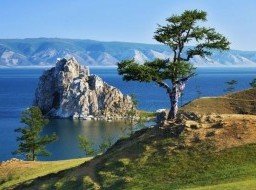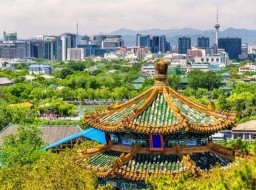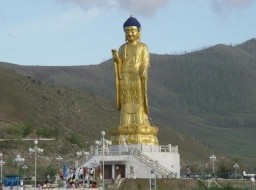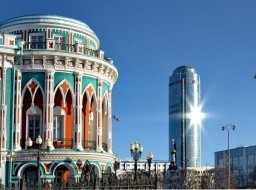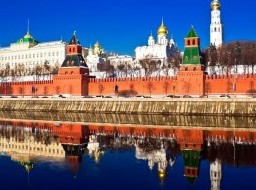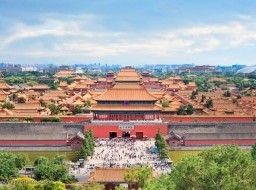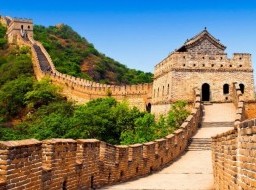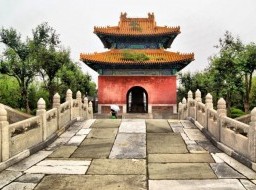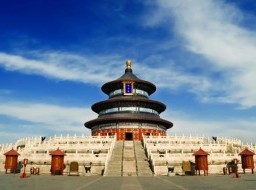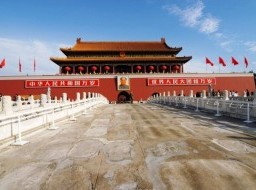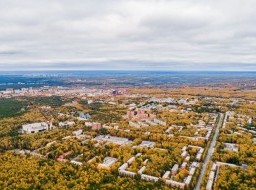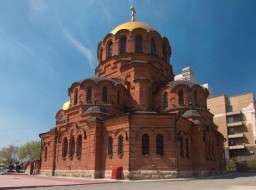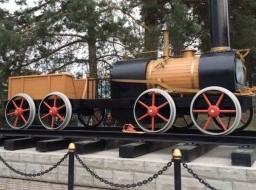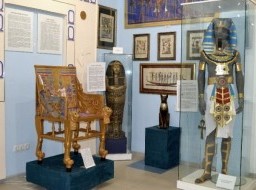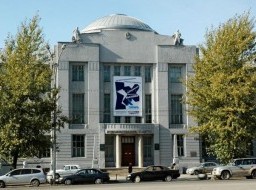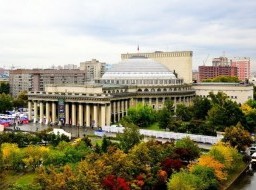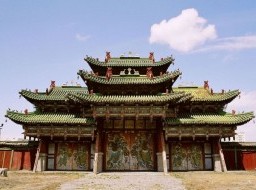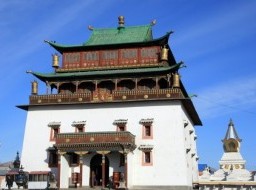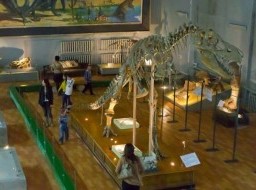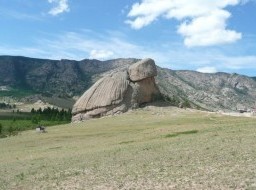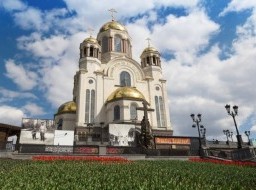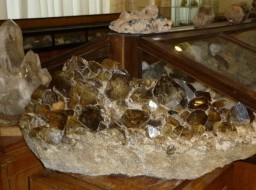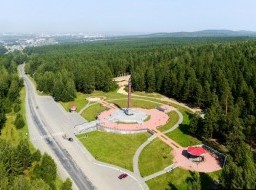Moscow - Yekaterinburg - Novosibirsk - Irkutsk - Ulaanbaatar - Beijing
In May 1891, the construction of the World’s longest and most difficult to build railway was started after years of controversy amongst the Czars: the Trans-Siberian railroad. The link between Moscow and Vladivostok, some 6.000 miles apart, was completed 14 years later employing a labour force of over 90.000. Ever since the rail service linking Europe with the Far East was established at the turn of last century, foreign travellers and adventurers have been fascinated by this great journey and crossed Siberia to reach the Pacific or China. Across the Ural mountains to Siberia, through towns that were built along the rails into the Mongolian steps and Gobi desert, the Trans-Siberian journey offers a great opportunity to experience an unforgettable journey. You will meet local people and learn about their culture and way of life and be part of it.
Starting point is Moscow, where you’ll enjoy the vibrant atmosphere of this bustling city before boarding the Trans-Siberian train and passing by the Ural. Your journey will bring you then to Yekaterinburg, where the last Tsar died, to Novosibirsk, the largest city of Siberia, to Irkutsk, the “Paris” of Siberia, where you will spend a few days at the world’s largest and cleanest lake, namely Lake Baikal. Then you will continue to Ulaanbaatar, where you will experience the Nomadic life of the Mongolian people, and finally, the train will take you to Beijing, the capital of the Chinese empire, where your journey ends.
Itinerary Hide all details
Arrive in Moscow by international flight. Transfer to the 3-star hotel for a one-night stay. City tour with the Sparrow Hills, pedestrian Arbat Street, Victory Park, Christ the Savior Cathedral. Free time.
Lunch & Dinner (optional).
Morning check-out. City tour with the Red Square & Alexander's Garden. Visit to the Kremlin with its territory and cathedrals, Armoury Museum and Diamond Fund. Lunch in the city. Afternoon transfer to the train station. Departure at 16.08 (daily) by train # 16 to Yekaterinburg.
Originally Yekaterinburg was founded as a capital of metallurgical region, center of mechanical engineering, a city of gold and precious stones. The location of the city is unique: it stands on the meeting of the Asian and European parts of the continent, an idiosyncratic key to the endless and rich Siberia, a window to the Asia as St. Petersburg - a window to the Europe. We cross the Europe/ Asia divide before arrival in Yekaterinburg, capital of the Urals. We arrive in Yekaterinburg at 19.45. Arrival transfer. Accommodation at the 3-star hotel in the city center. Free time.
Dinner at the hotel (optional).
After checking-out from the hotel we'll go for a city tour. You'll see the architectural monuments of Russian classicism of the 18-19th centuries. You'll have the possibility to follow the last way of Romanov Dinasty visiting place of the former Ipatyev's House, exposing wax figures and authentic photos of the Emperor's family, visiting the place where the remains which might belong to the members of the tzar family were found (30 km from Yekaterinburg).
Geological Museum will show you a huge and unique collection of underground wealth of Urals accumulated here: 600 from 800 kinds of minerals known in Urals. You'll see the giant rock crystal just entering! That is the hugest and most beautiful rock crystal shown in the museums of Russia and Europe, its weight is 784 kg and it's 170 sm of height! Trip to the boarder of Europe and Asia will give you opportunity to see and visit this unique place. Free time with a guide in the city for a shopping and walking. Departure transfer to the train station. Departure at 21.04 by train# 56 on even dates/ at 21.04 by train 26 on odd dates to Novosibirsk.
Lunch and dinner in the city (optional).
Novosibirsk is the largest city and industrial center of Siberia. The geographical center of Russia, unofficially considered being a capital of Western Siberia. Novosibirsk is the largest scientific center in Siberia. The main feature of Novosibirsk is its virgin nature, its primeval beauty - Altai Mountains. We arrive in Novosibirsk at 18.00 by train# 56/ 26. Arrival transfer to the 3-star hotel in the city center.
Dinner at the hotel (optional).
City tour, during which you'll see Alexander Nevsky Cathedral, the first stone building raised in 19-20 cc, visit a backstage of the State Academic Opera and Ballet Theater, a building with 60-meters dome and 900 ml, the hugest theater building of Russia, railway bridge over the river Ob. Tour to the Akademgorodok (town of scientists). It's well known all over the world. A great number of discoveries in physics, chemistry, space technology was made here.
Excursion to the Sun Museum that is unique in the world. You will not find anything of that kind anywhere else. You'll see an incredible variety of representations of the Sun. You'll see paintings by Nikolai Rerikh, works of Russian paintings of the 18th-19th cc (Sourikov, Tropinin, Repin), samples of Western-European art, sculptures, graphics and applied art in the Art Gallery. And in the Museum of the Train you'll get known the history of train development and see different kinds of the trains. Free time at the hotel. Late departure transfer to the train station. Departure at 22.57 by train# 08/02 daily to Irkutsk.
Lunch and dinner in the city (optional).
Irkutsk is the capital of Irkutsk Region, one of the biggest and most interesting regions in Russia, the whole world in Eastern Siberia which is not far from the famous Lake Baikal. Irkutsk stands at the crossroads of the trade routes between the East and West. Arrive in Irkutsk early in the morning (at 06.45). Additional breakfast. And we have to go further and leave Irkutsk for the Lake Baikal. It takes about 1 hour to cover 70 km, the distance between Irkutsk city and the Lake Baikal. Baikal differs from the other lakes in the world by virtue of its unique depth, volume, the quality of its water and age for lakes exist usually for no more than of thousands of years, and finally, by virtue of its wildlife. If you dream about seeing the whole Lake you are welcome to cruise (but it's another story :)).
You'll walk around Listvyanka village, have a visit to St. Nicholas Church, get known the flora and fauna of the Lake Baikal after visiting Baikal Museum. Lunch at the restaurant at the Lake Baikal. Departure transfer back to Irkutsk. And on your way you'll visit the Museum of Wooden Architecture 'Taltsy'. Taltsy Museum represents a real Siberian village! You'll see unique monuments of the Russian wooden architecture of the XVII - XIX cc: the passing tower and the church of the Mother of God of Kazan from Ilimsky Burg (the exhibit of the 17th c), the parish school, farmsteads of peasants with plank bed, Rusian oven and the 'red corner' with icons in it.
After checking-in we'll go for the city tour. You'll see the oldest point of the city, the place where Irkutsk began and the modern part of the city with its unforgettable architecture and atmosphere.
You probably heard of the Decembrists, the Russian noble men -revolutionaries who instigated and uprising against autocracy and serfdom in St. Petersburg in December 1825 (their names are derived from the name of month of uprising). Some of them were hanged, the rest were imprisoned and exiled to Siberia. The Decembrists spent thirty-odd years in Siberia, first doing penal servitude in prison and then in exile in remote areas of the severe region. Many of the Decembrists' wives voluntarily followed their husbands into exile. They had to leave not only their former way of lives in St. Petersburg but they had to leave their children also. And you'll get known about it during the visit Decembrists' Museum. Later some of the Decembrists' families were given permission to move to the town towards the end of their term of exile. Their houses are still there. They are museums now.
If you'd like to feel the life of the city, to try to understand its soul you'd better to stay here for more time to walk by yourself and watch, and look, and see.
Dinner at the hotel (optional).
* If you'd like to stay at the Lake Baikal or in Irkutsk city for 1-2 nights more write us about it please and we'll make changes in the programme according your wishes.
Morning departure transfer to the train station. Departure at 05.43 by trains# 06/ 04 to Ulaan-Baatar (on Monday, Saturday and Sunday only). These very trains should help you to see the shore line of the Lake Baikal and get last 2 hours of admiring its beauty.
We arrive in Ulaan-Baatar at 07.30 by trains# 06/ 04. Ulaan-Baatar is the capital of Mongolia, country in the Northern Asia just between China and Russia, the 'Land of Blue Sky'. The land where human remains dating back nearly 500,000 years were uncovered in the Gobi Desert and other regions of Mongolia. Arrival transfer to the 4-star hotel. After additional breakfast at the hotel we'll go for the city tour. You'll see how the East meets the West here and how the promise of technology and modern values collides with the traditional culture: you can see young people talking on their phones nest to old men in traditional dress flipping their prayer breads, talking to the Gods; apartment buildings being close to gers in the outskirts of the city. You'll get known geography, flora and fauna, paleontology and anthropology of Mongolia at the Natural History Museum. You'll have an opportunity to see numerous objects from all over Mongolia, including precious stones, stuffed and embalmed animals, birds and fish. You'll find the awesome meteorites, impressive two complete skeletons of dinosaurs found in the Mongolian Gobi Desert. The museum is rich in dioramas. Lunch in the city. Afternoon you are visiting Bogd Khan Winter Palace. It used to be a winter residence of the last Bogd Khaan of Mongolia, the eighth Jebtzun Damba (Lord of Refuge), colorful and controversial character. Then you have time for shopping in the center. Back to the hotel and free time.
Dinner at the hotel (optional).
After breakfast we are going to the largest and most important monastery in Mongolia, one of the impressive sights of Ulaanbaatar, Gandan Monastery. Major religious ceremonies and festivities take place here, including tsam dance, a kind of theater performance. Trip to the Terelj National Park will let you get acquainted with the way of life of nomad people. Mongolians are nomadic herders. Most Mongolians continue to live in gers, large, white felt tents that can be moved easily. You have lunch there and go back to the city for the folk show in the evening.
Morning transfer to the train station. Departure at 08.05 by train# 24 to Beijing (on Thursday only).
But if you still have time and possibility you can extend your staying in Mongolia and drive to Karakorum, the former capital of vast Mongolian Empire built by Genghis Khan in 1220, with overnights in ger-camp (meals - full board) with English-speaking guide escort, visit nomad family, horse riding. Or if it's a summer time you can go to the Gobi Desert by car or by flight, vast zone of desert and semi-desert covering almost 30% of territory of Mongolia, to visit the Gurvansaikhan National Park, unlike other national parks in the Gobi Desert, containing mountains, dinosaur fossils, extraordinary sand dunes, rock formations and a valley that has ice for most of the year. You can visit the Yolyn Am Valley (Vulture's Mouth), originally established to conserve the bird life of the region. But now it's famous for its dramatic and very unusual scenery -it is a valley in the middle of the Gobi Desert with gorge full of meters-sick ice all year round. In winter ice is up to 10m high and continues down the gorge for another 10 km. It remains frozen for most of the year, except late August.
In the afternoon we arrive in Beijing, China. Arrival transfer. Accommodation at the 3-star hotel. Free time.
Lunch & Dinner (optional).
Breakfast at the hotel. City tour with a visit to The Forbidden City, Tian’anmen Square, Temple of Heaven. Lunch in the city. Free time.
Dinner (optional).
Breakfast at the hotel. Tour to the Great Wall & Ming Tombs. Lunch in the city.
Dinner (optional).
Transfers to the airport for departure by international flights.
What's included
- accommodation at the hotels as per itinerary;
- meals mentioned in the programme as included;
- arrival & departure transfers, all guided programmes;
- entrance fees.
The tour language is English. Other languages speaking guides are available on request and at a supplement.
- airfares;
- charges of a personal nature;
- any optional excursions;
- meals as optional;
- drinks;
- visa and excess luggage charges;
- insurance and laundry services, banks charges for money transfer.
All prices are subject to change without notice. Exact rates are confirmed at the time of booking.
As you can see below, we don't have special dates the tour to start. The dates can be on your possibility and wish, just see the days of train departures but the majority of them are daily. In any case, we'll do our best to find a train to let you leave this or that town according your plans.
Price
| Price package | Price per person | |
|---|---|---|
1 pax - single (1-st class train tickets)Price per person | Book now | |
1 pax - single (2-nd class train tickets)Price per person | Book now | |
2 pax - twin (1-st class train tickets)Price per person | Book now | |
2 pax - twin (2-nd class train tickets)Price per person | Book now | |
10 pax - twin (1-st class train tickets)Price per person | Book now | |
10 pax - twin (2-nd class train tickets)Price per person | Book now | |
10 pax - single (1-st class train tickets)Price per person | Book now | |
10 pax - single (2-nd class train tickets)Price per person | Book now |
Tour Reservation
Ready to buy? To complete your purchase, please select travel dates, travelers and click Purchase button.
Contact us
Just browsing or have a question? We will be happy to assist! Send a message to one of our awesome destination specialists.
Email usJust browsing or have a question? We will be happy to assist! Send a message to one of our awesome destination specialists.
Back to bookingVisa
Russian visa support (Russian visa invitation letter) is included.
Sights included in program
Thanks ! We will reply you in less than 24 hours (usually within 1-2 hours).
Thanks ! We will reply you in less than 24 hours (usually within 1-2 hours).
Our flexible payment options allow you to pay 20% of a deposit first and the remaining 80% in 14 days prior to your tour date - payment can be done both online or over the phone. This gives you the peace of mind knowing your spaces are booked on the tours and that you do not miss out on making the most of your time in Russia.
Also you get the best, top-rated and most experienced and knowledgeable hand-picked tour guide appointed on a priority basis.
In our experience, exceptional travel experiences are almost always delivered by exceptional people. With that in mind, we utilize a comprehensive approach to select and employ the best tour guides only. Multilingual and well travelled, each possesses deep insight into the diverse attractions and cultural patterns throughout the region. With us guides undergo a rigorous selection process, achieving outstanding knowledge of local culture and language. Rest assured that the best tour guides only will be working on the tours to give you excellent opportunity to explore the best of the sights during both short and long-term stay in Russia.
Speak to an expert
Call us now
+1 (888) 845-8877
- Home
- |
- Tours
- |
- Day tours
- |
- Rail tours
- |
- Shore excursions
- |
- My trip
- |
- About
Group Tour Packages
Company Information
US office
3422 Old Capitol Trail Suite 1252,
Wilmington DE, 19808 USA.
US toll-free: 1-888-845-8877
Russian office
Ligovsky pr. 57, Office 19,
191040, St. Petersburg, Russia
tel: +7-812-309-5339
© 2001 – 2025 by Northern Crown, Ltd. uVisitRussia and uVisitRussia.com are registered trademarks. Terms & Conditions Privacy Policy
Why Do You Need Our Travel Expert
Contact our experts, and they will help you to plan your best trip to Russia, with attention to every detail!
Our Experts have been in the travel industry for many years, guarantee to offer first class customer service, excellent value for money and unbiased advice. They are standing by to find and build your dream holiday to one of the world's most fascinating destinations - Russia.
Your personal Travel Expert will guide you through each stage of the travel process, from choosing a program that fits you best to support during your trip.
Just tell us your e-mail, and we'll take care of everything!
Ask a Travel Expert 
Leave your phone number
Your tour request has been received. Thank you !
We have sent you the confirmation message to [email]
Please make sure that you receive this message (sometimes e-mail messages may go to the spam/junk mail).
If you did not get this message, it means you will not get message with the tours' selection as well. If you use a Yahoo!, Gmail, AOL or Hotmail, we recommend to add request@uvisitrussia.com to your address book.
We recommend to leave your phone number. If we will not heard back that you received the e-mail with the tours' selection, we will contact you by phone.
And you will not miss the best tour for you.
Thank you ! Your request for Travel Expert assistance has been sent. We will e-mail you within 1 hour.

